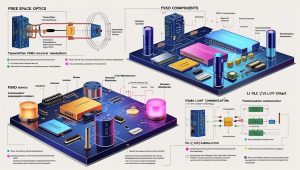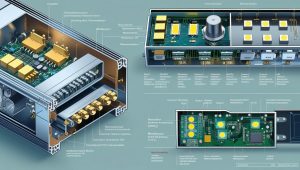As the world becomes increasingly data-driven, the demand for faster, more secure, and congestion-free wireless communication is reaching new heights. In this dynamic landscape, Li-Fi (Light Fidelity) technology is emerging as a transformative solution, poised to redefine how data is transmitted in homes, businesses, and public infrastructure. Using light waves instead of radio frequencies, Li-Fi offers ultra-fast, low-latency connectivity that addresses many of the limitations of traditional Wi-Fi and cellular networks.
With its potential to deliver speeds over 100 Gbps, unmatched security, and reduced electromagnetic interference, the Li-Fi technology market is on track for significant growth, driven by the accelerating need for high-speed connectivity in a digitally evolving world.
Understanding Li-Fi: Light as a Data Highway
Li-Fi is a wireless communication technology that uses visible light, infrared, or ultraviolet spectrum to transmit data. Unlike Wi-Fi, which operates using radio waves, Li-Fi leverages LED light sources to send information to devices equipped with photodetectors. Because light cannot pass through walls, Li-Fi offers highly localized and secure data transmission, making it ideal for settings where data privacy and speed are critical.
When LEDs modulate light at extremely high speeds—imperceptible to the human eye—they can encode vast amounts of data and transmit it in real time. This opens new possibilities in environments where radio frequency communication is limited, unreliable, or restricted due to interference.
Market Growth Drivers: Speed, Security, and Spectrum Efficiency
The global Li-Fi market is expected to grow at a robust compound annual growth rate (CAGR) over the next decade, fueled by several converging trends.
One major driver is the exploding demand for bandwidth. As streaming services, smart devices, IoT systems, and AI applications proliferate, current wireless infrastructure is being pushed to its limits. Li-Fi offers a solution by tapping into the vast, unlicensed light spectrum—freeing up congested radio frequencies and delivering superior data throughput.
Security concerns also play a significant role in Li-Fi’s rise. Because Li-Fi signals are confined to physical spaces and cannot be intercepted through walls, the technology offers enhanced data protection, making it ideal for financial institutions, government agencies, and defense applications.
Moreover, the growing deployment of LED lighting infrastructure across smart cities and smart buildings presents a natural platform for Li-Fi integration. By embedding data transmitters into existing lighting systems, cities and enterprises can create a dual-purpose network that illuminates spaces while enabling ultra-fast communication.
Download PDF Brochure @ https://www.marketsandmarkets.com/pdfdownloadNew.asp?id=946

Industry Applications: From Smart Homes to Healthcare
Li-Fi’s versatility opens it to a wide range of high-value applications. In smart homes, Li-Fi can support bandwidth-intensive activities like 8K video streaming, gaming, and smart automation—without RF interference. In enterprise settings, it enables secure file sharing and video conferencing in high-traffic areas.
In the healthcare sector, where electromagnetic interference from Wi-Fi can disrupt sensitive equipment, Li-Fi provides a safe and high-speed alternative. Hospitals can deploy Li-Fi to improve connectivity in operating rooms, imaging centers, and patient monitoring systems.
Aviation and transportation hubs also stand to benefit. Airplanes, where RF communication is heavily regulated, can use Li-Fi to provide high-speed in-flight entertainment or cockpit data links. Similarly, subway systems and underground networks can leverage Li-Fi for passenger information services where Wi-Fi struggles to reach.
Li-Fi is also gaining momentum in education, retail, and industrial automation. Classrooms equipped with Li-Fi can offer personalized learning experiences, while retailers can use localized light signals to deliver targeted promotions. In factories, Li-Fi can support fast, interference-free communication between robots and control systems.
Opportunities in the Li-Fi Technology Market
As digital transformation reshapes industries and connectivity becomes foundational to modern life, Li-Fi (Light Fidelity) technology offers a wide array of emerging opportunities. Unlike traditional wireless systems, Li-Fi’s use of light for data transmission opens new dimensions of speed, security, and spectrum availability. Below are key opportunity areas driving Li-Fi’s future growth:
1. Smart Cities and Smart Infrastructure
Li-Fi can be integrated into LED streetlights, traffic signals, and public lighting systems, transforming them into data hubs for urban infrastructure. This enables real-time traffic management, public Wi-Fi alternatives, and localized data services for pedestrians and autonomous vehicles—supporting the goals of smart, connected urban environments.
2. Healthcare and Hospital Systems
Hospitals are increasingly turning to interference-free communication systems to ensure the safe operation of medical equipment. Li-Fi provides a secure, high-speed alternative to Wi-Fi in operating rooms, imaging suites, and patient monitoring systems, offering critical support for telemedicine and health data exchange without electromagnetic interference.
3. Defense and Secure Communications
Given its line-of-sight limitation and inability to penetrate walls, Li-Fi is naturally secure, making it ideal for military bases, secure facilities, and government environments. Data confined to a room is less vulnerable to interception, providing enhanced cybersecurity and physical control over sensitive communications.

4. Industrial Automation and Industry 4.0
Factories and warehouses using robotics, sensors, and real-time analytics require low-latency, high-reliability networks. Li-Fi enables fast, localized communication that reduces RF congestion and supports the precise coordination of automated systems in industrial environments.
5. Aviation and Transportation
In-flight entertainment systems, cockpit communication, and cabin connectivity can all benefit from Li-Fi, where radio frequency interference is restricted or impractical. Similarly, underground metro systems and high-speed trains can use Li-Fi to provide fast, uninterrupted data services where Wi-Fi struggles to perform.
6. Retail and Indoor Navigation
Retail environments can use Li-Fi for hyper-localized marketing, indoor navigation, and smart shelf systems. Light fixtures in stores can deliver personalized offers, guide customers, and enable cashier-less shopping experiences—all via a consumer’s smartphone or wearable.
7. Education and Digital Classrooms
Li-Fi offers schools and universities secure, high-speed internet access in classrooms and lecture halls, especially in institutions with dense digital device usage. It also reduces RF exposure for young students and supports advanced interactive learning experiences.
8. Expanding the Internet of Things (IoT)
Li-Fi’s ability to support machine-to-machine (M2M) communication opens up new IoT possibilities. Smart homes, connected vehicles, and industrial sensors can benefit from the high data throughput and security offered by Li-Fi, especially in environments where RF noise is problematic.
Challenges and Outlook
Despite its promise, Li-Fi technology faces challenges that could affect adoption. Since light cannot pass through walls, coverage is limited to line-of-sight environments, requiring multiple light sources or hybrid systems with Wi-Fi to ensure seamless connectivity. Initial deployment costs and the need for specialized receivers in end-user devices are also hurdles.
However, continuous R&D, standardization efforts, and advances in photonic and sensor technology are rapidly addressing these limitations. Major players in the telecom, lighting, and semiconductor industries are investing heavily in commercializing Li-Fi solutions. Government support for smart infrastructure projects is further accelerating the ecosystem.
As the market matures, hybrid communication models that combine Li-Fi with existing RF-based technologies (Wi-Fi, 5G, Bluetooth) will likely become the norm, ensuring both speed and scalability.
Conclusion: A Bright Future for Light-Based Connectivity
Li-Fi is no longer just a lab experiment or a niche innovation—it is a viable, scalable, and powerful communication technology poised to complement and, in some cases, outperform traditional wireless networks. As the digital economy demands ever-faster, more secure, and interference-free data transmission, Li-Fi stands ready to illuminate the path forward.
With the convergence of smart lighting, edge computing, and IoT infrastructure, the Li-Fi technology market is entering a high-growth phase, unlocking new opportunities for industries, cities, and consumers alike. In the near future, every light source could become a potential access point—making high-speed connectivity as ubiquitous and seamless as switching on a light.
